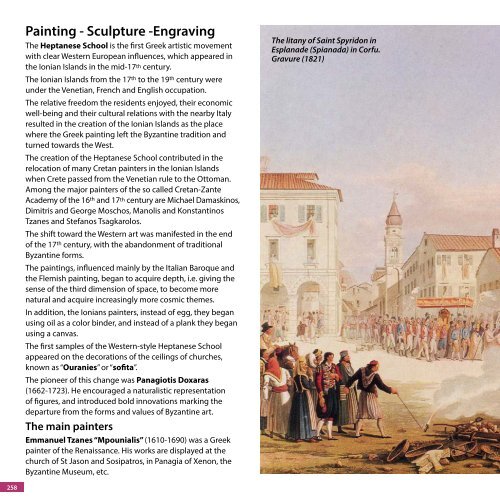You also want an ePaper? Increase the reach of your titles
YUMPU automatically turns print PDFs into web optimized ePapers that Google loves.
Painting - Sculpture -Engraving<br />
The Heptanese School is the first Greek artistic movement<br />
with clear Western European influences, which appeared in<br />
the Ionian Islands in the mid-17 th century.<br />
The Ionian Islands from the 17 th to the 19 th century were<br />
under the Venetian, French and <strong>English</strong> occupation.<br />
The relative freedom the residents enjoyed, their economic<br />
well-being and their cultural relations with the nearby Italy<br />
resulted in the creation of the Ionian Islands as the place<br />
where the Greek painting left the Byzantine tradition and<br />
turned towards the West.<br />
The creation of the Heptanese School contributed in the<br />
relocation of many Cretan painters in the Ionian Islands<br />
when Crete passed from the Venetian rule to the Ottoman.<br />
Among the major painters of the so called Cretan-Zante<br />
Academy of the 16 th and 17 th century are Michael Damaskinos,<br />
Dimitris and George Moschos, Manolis and Konstantinos<br />
Tzanes and Stefanos Tsagkarolos.<br />
The shift toward the Western art was manifested in the end<br />
of the 17 th century, with the abandonment of traditional<br />
Byzantine forms.<br />
The paintings, influenced mainly by the Italian Baroque and<br />
the Flemish painting, began to acquire depth, i.e. giving the<br />
sense of the third dimension of space, to become more<br />
natural and acquire increasingly more cosmic themes.<br />
In addition, the Ionians painters, instead of egg, they began<br />
using oil as a color binder, and instead of a plank they began<br />
using a canvas.<br />
The first samples of the Western-style Heptanese School<br />
appeared on the decorations of the ceilings of churches,<br />
known as “Ouranies” or “sofita”.<br />
The pioneer of this change was Panagiotis Doxaras<br />
(1662-1723). He encouraged a naturalistic representation<br />
of figures, and introduced bold innovations marking the<br />
departure from the forms and values of Byzantine art.<br />
The main painters<br />
Emmanuel Tzanes “Mpounialis” (1610-1690) was a Greek<br />
painter of the Renaissance. His works are displayed at the<br />
church of St Jason and Sosipatros, in Panagia of Xenon, the<br />
Byzantine Museum, etc.<br />
The litany of Saint Spyridon in<br />
Esplanade (Spianada) in Corfu.<br />
Gravure (1821)<br />
258



